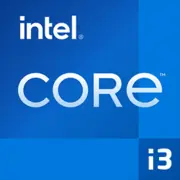Intel Core i3-13100F

Intel Core i3-13100F: Budget Processor for Gaming and Work in 2025
Updated: March 2025
Key Features: Raptor Lake in a Compact Form
The Intel Core i3-13100F belongs to the Raptor Lake generation while retaining characteristics of its budget line. It is a 4-core chip with 8 threads thanks to Hyper-Threading, allowing it to compete in multi-threaded tasks. The Intel 7 process (10 nm Enhanced SuperFin) strikes a balance between energy efficiency and performance.
Key Specifications:
- Base/Max Frequency: 3.4 GHz / 4.5 GHz (Turbo Boost 2.0).
- Cache: 12 MB L3 — double that of the i3-12100F.
- TDP: 58 W — easily cooled even with a stock cooler.
- Integration: No integrated graphics (indicated by "F"), so a discrete graphics card is required.
Performance:
According to Geekbench 6, the i3-13100F scores 2280 in single-core and 7760 in multi-core tests. This is a 12% increase over the i3-12100F, thanks to Raptor Lake optimizations. In games like Cyberpunk 2077 or Apex Legends, the processor consistently delivers 60+ FPS when paired with a graphics card like the NVIDIA RTX 3060.
Architectural Features:
- PCIe 5.0 support (16 lanes) — relevant for next-generation SSDs.
- Intel Thread Director technologies for thread optimization in hybrid applications.
Compatible Motherboards: LGA 1700 Socket and Chipset Choices
The i3-13100F uses the LGA 1700 socket, compatible with 600 and 700 series chipsets.
Recommended Chipsets:
1. H610/B660 (DDR4): Budget option for office PCs. Example: ASUS Prime H610M-K ($85).
2. B760 (DDR5): Optimal choice for gaming builds. Example: MSI Pro B760M-A WiFi ($140).
3. Z690/Z790: Overkill for i3, but suitable for upgrading to i5/i7.
Important:
- BIOS updates may be required for 600 series motherboards.
- For PCIe 5.0, choose models with Gen5 support (e.g., Gigabyte Z790 UD).
Supported Memory: DDR4 vs DDR5
The processor works with DDR4-3200 and DDR5-4800, but the type of memory depends on the motherboard.
Comparison:
- DDR4-3200 (CL16): Affordable option (32 GB — $70), suitable for gaming and everyday tasks.
- DDR5-4800 (CL40): More expensive (32 GB — $110), but yields a 5-10% boost in CPU-dependent games (Microsoft Flight Simulator, CS2).
Recommendation: For a budget build, choose DDR4. If considering an upgrade, opt for DDR5.
Power Supply: Minimum Requirements and Tips
With a TDP of 58 W, the processor does not require a high-capacity power supply.
Power Calculation:
- Without a graphics card: 300 W.
- With RTX 3060 (170 W): 500 W (recommended 80 Plus Bronze).
- With RTX 4070 (200 W): 650 W (80 Plus Gold).
Power Supply Examples:
- EVGA 500 BR ($50) — for RTX 3050.
- Corsair CX650M ($80) — for RTX 4060.
Pros and Cons of the i3-13100F
Pros:
- Price: $120 (new) — one of the most affordable CPUs for 2023-2024.
- Energy efficiency: suitable for compact cases.
- Gaming performance: rivals Ryzen 5 5500.
Cons:
- 4 cores: limitation in heavy multi-threading (rendering, streaming).
- No integrated graphics: cannot operate without a graphics card.
Use Cases: Where the i3-13100F Will Shine
1. Gaming: Ideal for Full HD gaming with a GPU like the RTX 3060/RX 6600. In Fortnite (Epic) — 90 FPS, in Elden Ring — 60 FPS.
2. Office Tasks: Multitasking with a dozen tabs, Excel, Zoom.
3. Multimedia: Streaming 4K video, editing in DaVinci Resolve (projects up to 1080p).
Limitations: Not suitable for 3D rendering in Blender or working with neural networks.
Comparison with Competitors
1. AMD Ryzen 5 5500 ($100): 6 cores, but weaker in single-core tests (Geekbench 6 SC: 1980). Better in multi-threading.
2. Intel Core i5-12400F ($160): 6 cores/12 threads, Geekbench 6 MC: 9200. A choice for those needing future-proof performance.
3. Ryzen 5 5600 ($130): Higher gaming performance (+8%), but more expensive.
Conclusion: The i3-13100F excels in price and power consumption, but falls behind 6-core models in multi-threading.
Building Tips for a PC with i3-13100F
1. Cooler: The stock cooler is sufficient, but for quieter operation, consider the DeepCool AG400 ($20).
2. Motherboard: B760 + DDR5 if the budget allows.
3. Graphics Card: Don't skimp — go for RTX 3060 or RX 7600.
4. Storage: PCIe 4.0 SSD (WD Black SN770 1TB — $80).
Mistakes to Avoid:
- Buying a Z790 for i3 — excessive.
- Using DDR5-6000 — the processor does not support such frequencies.
Final Verdict: Who Should Consider the i3-13100F?
This processor is an excellent choice for:
- Budget Gamers: Maximum FPS for $120.
- Office PCs: Reliability and low power consumption.
- Home Media Centers: 4K streaming without hiccups.
Why in 2025?
Despite the launch of new generations, the i3-13100F remains relevant due to its low price and compatibility with modern platforms. It is a "workhorse" for those not willing to overspend on excess power.
Prices are current as of March 2025.
Basic
CPU Specifications
Memory Specifications
Miscellaneous
Benchmarks
Compared to Other CPU
Share in social media
Or Link To Us
<a href="https://cputronic.com/cpu/intel-core-i3-13100f" target="_blank">Intel Core i3-13100F</a>